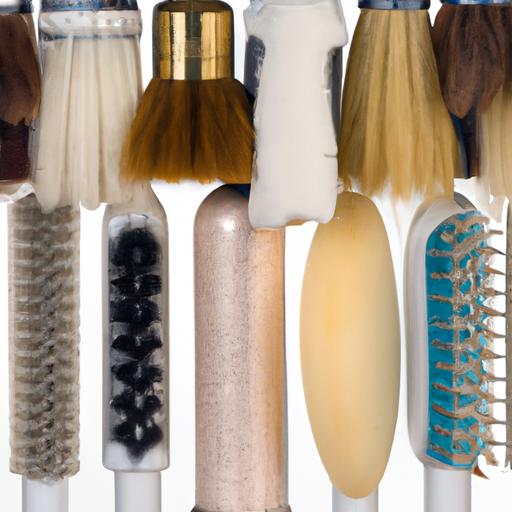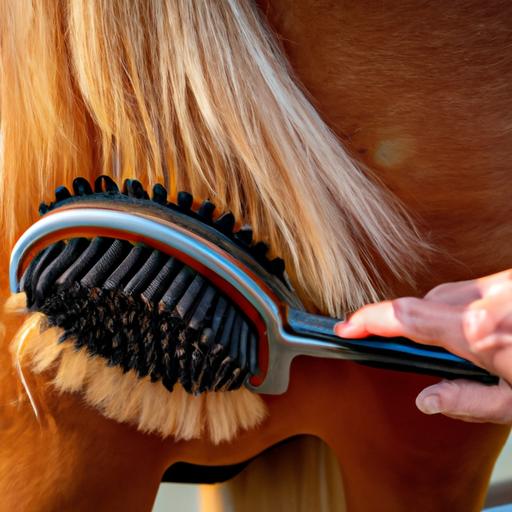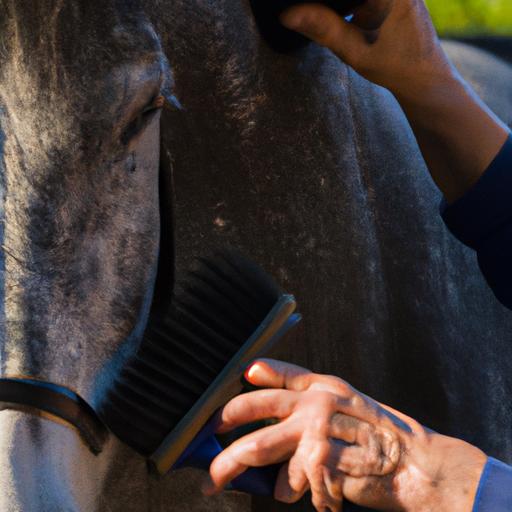Discover the correct order of brushes when grooming a horse for optimal results. Learn additional tips for effective horse grooming. Improve your equine’s well-being.
As a horse enthusiast, I’m sure you understand the importance of grooming for your equine companion’s overall health and well-being. Grooming is not just about making your horse look good; it plays a vital role in maintaining their coat, skin, and overall appearance. And when it comes to grooming, brushes are the unsung heroes of the process. They help to remove dirt, debris, and loose hair, while also stimulating blood circulation and enhancing the natural shine of your horse’s coat.
So, let’s delve into the world of horse grooming brushes and discover the correct order in which they should be used. By following this order, you’ll ensure that your grooming routine is effective and beneficial for your beloved horse.
Brushes play a crucial role in the grooming process. They help to remove dirt, dust, and sweat from the horse’s coat, promoting a clean and healthy appearance. Moreover, brushing aids in distributing natural oils throughout the coat, which not only adds shine but also helps to keep the skin moisturized. Additionally, regular brushing helps to prevent the formation of mats and tangles in the mane and tail, making them more manageable.
Now that we understand the significance of brushes in grooming, let’s explore the order in which they should be used. This proper sequence allows for a systematic approach to grooming, ensuring that each brush fulfills its specific purpose and contributes to a comprehensive cleaning routine.
Understanding the Basic Grooming Tools

Overview of Essential Grooming Tools for Horses
Before we dive deeper into the order of brushes, let’s take a moment to familiarize ourselves with the essential grooming tools required for proper horse care. These tools include brushes, combs, and other grooming accessories, each serving a specific purpose in maintaining your horse’s appearance and well-being.
Brushes: Brushes are the backbone of any grooming routine. They come in various shapes, sizes, and bristle types to cater to different grooming needs. From soft-bristled brushes for gentle cleaning to stiff-bristled brushes for removing tough dirt and debris, there is a brush for every grooming task.
Combs: Combs are particularly useful for untangling and maintaining the horse’s mane and tail. They help to remove knots and mats, keeping the hair manageable and preventing discomfort for your horse.
Hoof Picks: Hoof picks are essential for maintaining the health of your horse’s hooves. They allow you to remove dirt, debris, and stones from the hooves, preventing discomfort and potential injuries.
Sponges and Towels: Sponges and towels are handy for cleaning sensitive areas like the face and eyes. They allow for gentle cleaning and help to remove sweat and dirt from these delicate areas.
Importance of Using Appropriate Brushes
Now that we have a basic understanding of the grooming tools, let’s emphasize the importance of using the right brushes for each grooming task. Using inappropriate brushes can cause discomfort or even harm to your horse. For instance, using a stiff-bristled brush on sensitive areas like the face or legs can cause irritation or injury.
By selecting the appropriate brushes, you ensure a comfortable grooming experience for your horse while effectively addressing their grooming needs. Soft-bristled brushes are ideal for initial cleaning and removing surface dust, while stiff-bristled brushes excel at getting rid of stubborn dirt and debris. Curry combs provide a gentle massage that not only loosens dirt but also stimulates blood circulation. Dandy brushes help remove deep-seated dirt and bring out the natural shine of your horse’s coat. Body brushes provide the final touch, leaving your horse looking sleek and well-groomed.
Remember, using the right tools not only enhances the effectiveness of your grooming routine but also ensures the well-being and comfort of your horse. Now that we have a firm grasp on the basic grooming tools and their importance, let’s move on to the next section to uncover the order in which these brushes should be used.
The Order of Brushes in Horse Grooming

Step-by-step guide for effective horse grooming
When it comes to grooming your horse, following a step-by-step guide ensures that you cover all the necessary aspects. Not only does this make your grooming routine more thorough, but it also helps you ensure that your horse enjoys the process. Let’s explore the proper sequence of brushes to use, ensuring a comprehensive and effective grooming session.
Proper sequence of brushes to use
-
Soft-bristled brush for initial cleaning:
Start by using a soft-bristled brush to gently remove loose dirt, dust, and debris from your horse’s coat. This brush is perfect for sensitive areas such as the face and legs, providing a gentle and soothing grooming experience. -
Stiff-bristled brush for removing dirt and debris:
Next, use a stiff-bristled brush to remove stubborn dirt and debris from your horse’s coat. This brush is particularly effective at removing dried mud and sweat, leaving the coat looking clean and fresh. -
Curry comb for loosening dirt and stimulating blood circulation:
The curry comb is a fantastic tool for loosening dirt, removing loose hair, and stimulating blood circulation in your horse’s skin. Use circular motions over the entire body, paying extra attention to areas prone to sweat buildup, such as the neck and back. -
Dandy brush for further dirt removal and bringing out natural shine:
The dandy brush, with its long, stiff bristles, is excellent for removing any remaining dirt, dust, or loose hair. Use swift flicking motions to whisk away debris and bring out the natural shine of your horse’s coat. -
Body brush for final grooming and enhancing coat appearance:
The body brush is the brush that truly brings out the beauty of your horse’s coat. It removes the last traces of dirt, polishes the coat, and enhances its overall appearance. Use long, smooth strokes in the direction of hair growth for a glossy finish. -
Finishing touches with a mane and tail brush:
Finally, use a specialized mane and tail brush to detangle and neaten your horse’s mane and tail. This brush is designed to be gentle yet effective, ensuring that your horse’s flowing locks look their best.
By following this order of brushes, you’ll ensure that your horse receives a thorough and enjoyable grooming session. Remember to always use gentle and soothing strokes, keeping your horse’s comfort in mind at all times. Grooming is not only essential for your horse’s physical health but also provides a wonderful bonding experience between you and your equine companion.
Importance of Proper Brushing Techniques
Ensuring Horse’s Comfort during Grooming
When grooming your horse, it is crucial to prioritize their comfort. Just like humans, horses have sensitive skin that can be easily irritated or injured if not handled with care. To ensure a positive grooming experience for your horse, consider the following tips:
-
Be gentle: Use light pressure when brushing to avoid causing any discomfort. Start with soft strokes and gradually increase pressure as needed, but always be mindful of your horse’s reactions.
-
Pay attention to sensitive areas: Certain areas, such as the belly, face, and legs, may be more sensitive than others. Take extra care when brushing these areas, using shorter and softer strokes to minimize any potential discomfort.
-
Watch for signs of discomfort: Pay attention to your horse’s body language and reactions during grooming. If they show signs of discomfort, such as twitching, tensing, or swishing their tail, adjust your brushing technique accordingly or give them a break if needed.
Correct Brushing Motions to Avoid Discomfort or Injury
Using the right brushing motions is equally important to ensure your horse’s well-being during grooming. Here are some guidelines to follow:
-
Brush in the direction of hair growth: Always brush in the direction of your horse’s hair growth. This helps to avoid pulling or breaking the hair and minimizes the risk of causing discomfort or skin irritation.
-
Use long, sweeping strokes: Instead of quick, short strokes, opt for long and sweeping motions. This allows the brush to effectively remove dirt and debris while also providing a soothing massage-like sensation for your horse.
-
Avoid brushing sensitive areas aggressively: When brushing sensitive areas, such as the mane, tail, or face, use gentle and deliberate strokes. Take the time to untangle any knots or mats slowly and patiently, minimizing the risk of causing discomfort or injury.
By following these proper brushing techniques, you can ensure that your grooming sessions are enjoyable and beneficial for both you and your horse. Remember, grooming should be a bonding experience that promotes relaxation and nurtures the trust between you and your equine companion.
Conclusion
In conclusion, understanding the order of brushes when grooming a horse is essential for maintaining their health, appearance, and overall well-being. By following the proper sequence, you can ensure that each brush serves its purpose in the grooming process, from initial cleaning to the finishing touches.
Grooming is not just about keeping your horse looking good; it is a vital aspect of their care routine. Regular grooming helps to remove dirt, sweat, and debris, preventing skin issues and promoting a healthy coat. Furthermore, it allows for bonding time between you and your horse, fostering trust and strengthening your relationship.
Remember, when grooming your horse, always start with a soft-bristled brush to remove loose dirt and debris. Then, move on to a stiff-bristled brush to thoroughly clean the coat. The curry comb should be used next, followed by the dandy brush for further dirt removal and bringing out the natural shine. The body brush will provide the final grooming touch, enhancing the appearance of the coat. Lastly, don’t forget to pay attention to the mane and tail with a specialized brush.
In addition to the order of brushes, there are a few other tips to keep in mind for effective horse grooming. Regularly check your horse for any skin issues or injuries, as early detection can prevent further complications. It is also crucial to maintain the cleanliness and hygiene of your grooming tools to avoid the transfer of bacteria. Lastly, establish a grooming routine that works for both you and your horse, ensuring consistent care and optimal results.
By incorporating these tips and following the proper order of brushes when grooming your horse, you’ll not only keep them looking their best but also contribute to their overall health and happiness. So, make grooming a regular part of your horse care routine and watch as your equine companion shines with radiance and vitality.
Bold: Horsemasterypro.com


